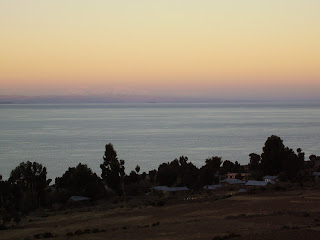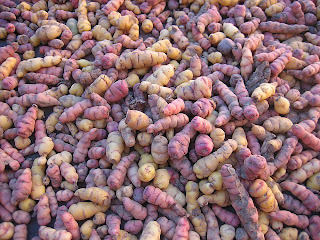While I am drinking my coffee, I thought I would write Part 2 of my Part 4 blog series on the crazy zone changes of Peru. I know when school starts, I won't have time to write and go in depth about things like I can now. And I have so much stored to write about....so what is the purpose of this particular series? And how does it relate to gardening? I think this particular trip spoke to me of microclimates and how we can create our own microclimates in the hot sunny desert. There are those who believe in the cactus and scrub brush type yards...don't get me wrong, I love those as well, and they have their place in this city. I mean, it's the whole reason for moving here....nothing like mountains, canyons, cool cactus, Spanish speaking people, crazy monsoon storms, and gardening all year round. It's a haven for a Spanish teacher....now if we could just get that red wine flowing like in Sonoma, Napa, or Glen Ellen, CA. Rumor has it that there is a winery down south.....it sounds like a day trip down the road this fall......and of course, there is my yearly trip to Wilcox for some good ol' apple picking at the orchard....yum. But right now I am going to focus on the microclimate portion of this blog......:)
 |
| Sunset on Amantani |
 |
| Finger potatoes left to dry in the cold night on people's doorsteps on the island of Amantani |
We went from the hot Amazon to the cool windy islands of Lake Titicaca. Go ahead...laugh...all my students do:) It is a funny name. It is said that the mighty Incans were born from this freshwater lake and moved into the Andes mountains. I cannot tell you what a cold snap and elevation hike it was to get to this place. We went through a riot in Cuzco and grabbed an 8 hour bus ride there. Farmers were protesting and throwing rocks at the bus blocking major roads with tire fires. This has been a traditional way to protest among the Quechua Indians who have taken a hit by government due to loss of lands and monies. The same thing happened with the Mayan Indians of Guatemala and Southern Mexico. If it's one thing that I have learned so far on my journeys to exotic places; it's that the Mayan and Quechua Indians are not to be messed with....while native peoples and their languages are disappearing at an alarming rate (along with their plant knowledge).....these two groups have fought bloody civil wars to protect their heritage..... and won. The governments of Guatemala and Bolivia are extreme cases of where the native peoples have gained control. It makes me smile....just don't want to be around it all when they are decapitating heads, etc.
 |
| The ways remain the same as they were 500 years ago |
 |
| Timeless |
So now that you have the background, Peru is known for the thousands of varieties of potatoes...there are so many!!! Black ones, purple ones, big ones, teeny tiny ones, sweet ones, dried ones......wow!!! Lake Titicaca has a huge production of potatoes around the lake and even on her islands...you will see some fields in the pics. They also produce the grain, quinoa, which is used in soups and has the most delicious flavor ever!!! I do get excited about these things...I don't know why....but I love food and I love trying new dishes with things we can't always get here in the States. Quinoa is now sold almost everywhere and people are starting to learn about this yummy grain. I even see the finger potatoes now sold in stores. There are some really good recipes out there with that particular variety of potato...cut them up and cover them with olive oil and put them in the oven.....yum.:) Needless to say, while in Peru, you will no doubt try many dishes that will include some sort of potato.
 |
| You can see Boliva from the coast of Amantani |
 |
| The Reed Islands...the floating islands of Uros. The Uros Indians used fishing to survive on Lake Titicaca and protect themselves from the warring Spanish conquistadors and Incan indians. Sadly, they are a dying group of Indians. Many of their children are going to the mainland to find work and their ways are disappearing. |
What surprised me about this area was the fact that traditionally "cold" plants that grow in my hometown of Wisconsin had things like desert cactus and the tropical sun thirsty passion fruit vine. If it's one thing I learned is that the Andes' people know their plants and knew exactly where to put their plants for best results. It also created their microclimates by carefully placing trees against the sharp wind off the lake. It was extremely cold there during the winter....and it was also cooler during their summer...very similiar to Wisconsin (without the snow but glaciers can be seen from their coast)....and yet they had cactus and tropical vines growing during their winter. It was a very unique place as you'll see in these pictures. And speaking of cold....who knew flamingos lived around Lake Titicaca? Wow. I'm going to wander a bit now to elaborate on my writing, but I'll circle back...promise:)
 |
| A traditional meal on the islands |
 |
| Notice the grading of the hill to catch any water before it goes into the lake |
 |
The fields of Amantani
|
Microclimates. Here in Tucson and surrounding areas, I have found that things will do well if you have established plants. On my walk every night around the neighborhood, I look at how people utilize their landscaping (or not), but I think most people on my good side of the neighborhood love to garden because their front yards show it....I am close to the Sam Hughes and Encantada neighborhoods where we have a lot of old growth because we are in central Tucson. Phase one of the property was to prune, get tools, fix up ugly benches, and fix leaky water valves. Phase two is currently the creation of the "green screen" that is creating the canopy for my tropicals including edible landscaping for the homeowners. Vines and a natural green wall utilizing oleanders, etc to cover the fences are also being used to segment the property and give it an enclosed feel. Phase 3 is the phase that most of the homeowners are waiting for....the color splash using beautiful pots and garden art with fountain and solar lights. This will also have the flowers that everyone is dying to see. Butterfly bushes and filler type plants will be added for our wildlife. I am not necessarily a flower person as I think leaves are beautiful as well. The flowers are just an added bonus. Phase 4 is the establishment of a water line and reconstruction of the shed and addition of rain water collectors. But the microclimate has to be established first so that we can add all those cutesy little details. I have seen some beautiful gardens up in Phoenix that utilize this technique.
 |
<><><><><><>
<>

The Ispi fish caught in Lake Titicaca and left to dry on the shores. | <><><><><><>
There is an apartment complex near 7th Ave and Osborne in Phoenix. It is a gated complex. I lived there for 1 year after Peace Corps and it utilizes the microclimate technique that has all the proper shading requirements. I remember standing on my balcony seeing the Phoenix skyline surrounded by a forest of trees and tropical plants. You couldn't hear the traffic...just the moon, birds, skyline and the forest. But I was renting and none of it was permanent for me....but it has remained in my head, this vision of perfection....the wildlife sanctuary amongst the urban landscape. I told myself, "Someday when you grow up and buy a place, this is what you want." Being a new homeowner, we couldn't obviously buy a trillion dollar hacienda style home, but the courtyard of El Presidio shocked me....so much potential and yet it had been neglected....and that vision came back to me of what it could be. The message here....you don't have to settle; just change the definition a bit to make it possible:) Anything is possible and you don't need a billion dollars to do it.
 |
| A Last Stand. The Uros Islands |
 |
| Me standing at the gates of the Taquille Island |
 |
The white caps are glaciers from Amantani
|
As a Spanish teacher who loves all things related to the latin cultures, I dream of that large home with a central private courtyard someday. I see myself drinking red wine(pinot of course) with an avocado tree somewhere in the courtyard....maybe our retirement home in Orizaba, Veracruz or Xalapa?
 |
The Passion Vine on Amantani
|
Lake Titicaca proves that it can be done....a plant, if properly placed, can work with the right soil and right shade. The key is....you can't have snow or severe freezing temps for our subtropical climate. And that was really great to see....especially on the windy islands of Amantani and Taquille where the native peoples have not changed for hundreds of years. Life is the same as it was so long ago because the people created their garden on a small isolated island. They did it to survive and have done so for countless generations. If you go, spend a night or two with the people in their homes. Bring sugar, fresh fruits and supplies for gifts as they still barter:) Happy gardening:)
 |
| Add caption |
 |
<><><><><><>
<>

My little sister wearing the traditional wear of the Amantani people | <><><><><><>



















That ugly fruit above is the delicious passion fruit. You spoon it out and eat it:)
ReplyDeleteIt is so nice to see another garden blogger from Arizona :-)
ReplyDeleteI love to travel and your pictures of Peru make me want to visit.
I find microclimates fascinating - especially when you find a plant that is thriving when normally you would never find one growing in our desert climate.
BTW, years ago, we visited a vineyard in Florence. I'm not sure it is still there, but just in case...you may want to check it out :-)
The same here....I look forard to reading your blog as well:) I have wanted to see this vineyard for years and I'll get there eventually:) I'm actually hoping it's this September...but I do think it's Florence as well. Enjoy your week:)
ReplyDelete